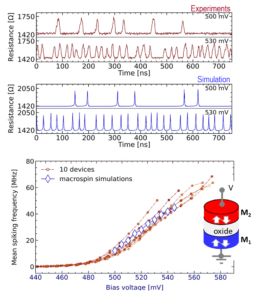We demonstrate that a perpendicular magnetic tunnel junction (MTJ) is capable of emulating an artificial spiked neuron. The magnetic stack has been designed so that the MTJ has two free layers, whose magnetization can be driven in a windmill-like dynamic by the spin transfer torque. The output-spiking rate is tunable by the dc bias voltage. This compact, field-free operating device is a practical solution for the development of spiking neural networks.

Experimental and simulated time traces of the resistance of a p-MTJ under bias voltages of 500 and 530 mV. The mean spiking rate vs bias voltage. Schematics of the pMTJ pillar.
Our goal is to develop a compact spintronic device able to generate an output signal with spikes upon injecting a DC current and thus mimicking a neuron function. The structure of our magnetic tunnel junction consists of two thin ferromagnetic layers with switchable magnetization oriented out-of-plane (OOP) owing to the perpendicular anisotropy induced at the interface with the Mg oxide spacer layer separating them (see schematics in the figure). Depending on the relative orientation of the magnetization of the two ferromagnetic layers (M1 and M2), the junction resistance changes due to different tunneling probabilities of spin up and spin down electrons across the barrier. The properties of the complete stack are designed so that the two magnetic layers have similar thermal stability, so that both of their magnetizations can be reversed by spin-transfer torque (STT). Under suitable conditions of applied voltage (V) and magnetic field, the magnetization of both layers switches continuously, creating an oscillation between anti-parallel (AP) and parallel (P) resistance states. Each transition between the AP and P states is associated with a sharp variation in resistance, similar to a spike.
Time-resolved resistance measurements performed on individual nanopillars with lateral size ~80nm unveil a windmill dynamic state (see figure), in which there is a sequential and perpetual switching of the two magnetic layers. The dc bias voltage is used as a parameter to control the magnetization dynamics, generating signals similar to a firing event in biologically inspired neurons. The bias voltage can be adjusted to regulate the spiking rate, which can reach up to tens of MHz, as demonstrated by both experiments and simulations.
Our proof-of-concept device works at reasonable bias voltage and zero applied field, and these two features are relevant for large-scale integration. The small energy consumption of the device (4−16 pJ/spike) and its scalability are important benefits for embedded applications. The windmill-like dynamics have straightforward applications in brain-inspired computing, stochastic computing, in-memory computing, and sensors.
Team:THEORY/SIMULATION, MRAM
Collaboration: Unité Mixte de Physique CNRS/Thales
Funding: Spinspike ANR-20-CE24-0002, nanofabrication – PTA
Further reading: Spiking dynamics in dual free layer perpendicular magnetic tunnel junctions, L. Farcis, B. M. S. Teixeira, Ph.Talatchian, D. Salomoni, U.Ebels, S. Auffret, B. Dieny, F. A. Mizrahi, J. Grollier, R. C. Sousa, and L. D. Buda-Prejbeanu, Nano Lett. 23, 7869 (2023). Open access: hal-04204509
Contacts: Liliana Buda-Prejbeanu, Ricardo Sousa




